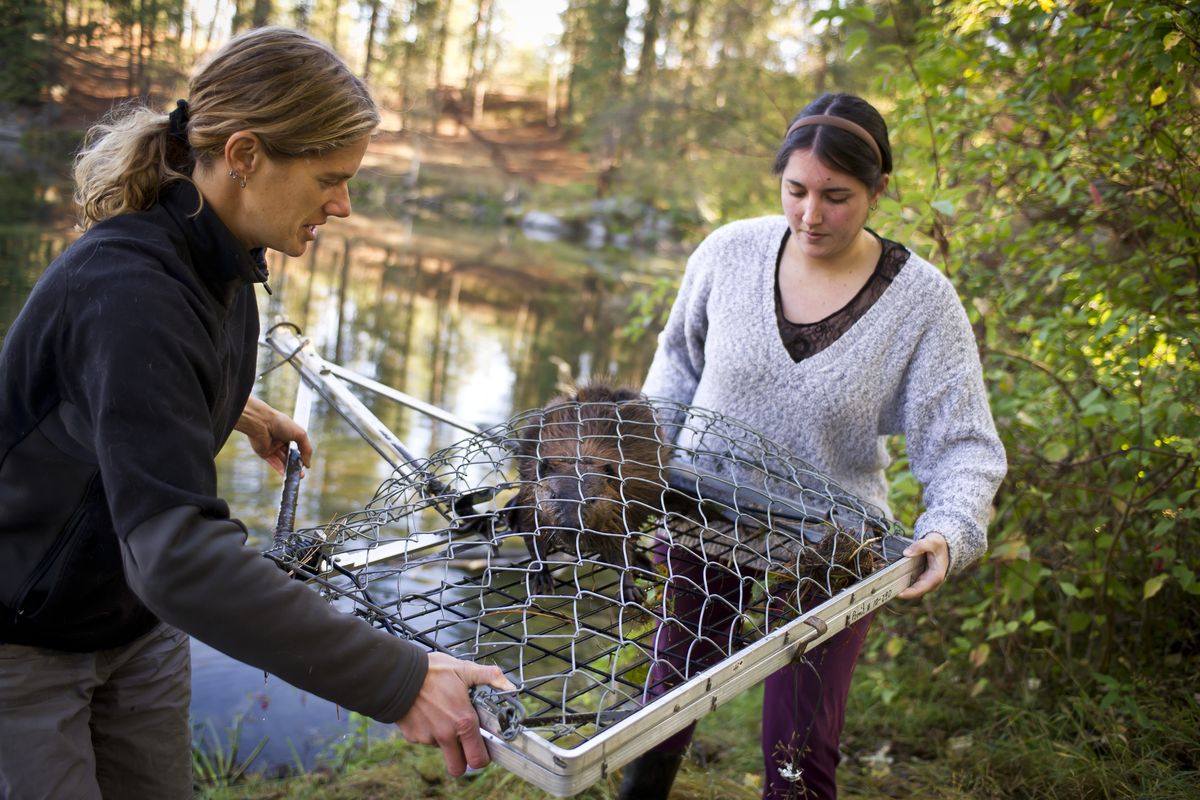Beavers just too dam busy
Nine-member rodent family removed from Red Lake

A few years ago, two beavers took up residence at Red Lake near Tum Tum, Wash.
Each spring, they produced kits, until the small, spring-fed lake was home to nine of the industrious rodents. Neighbors watched with concern as the beavers chewed their way through stands of cottonwoods and alders, and started girdling pine trees.
“The lake had been surrounded by trees,” said Les Smith, who lives nearby. “They were altering the look of the land.”
Calls to the Washington Department of Fish and Wildlife resulted in a humane solution. The neighbors were referred to a beaver relocation program.
The nine beavers were live-trapped by The Lands Council, a Spokane-based nonprofit. They’ll be released on private property near Priest River, where the landowner wants beaver dams and ponds for wildlife habitat and water storage.
Most nuisance beavers are euthanized, so relocation is “a nice option to have,” said Madonna Luers, a Fish and Wildlife spokeswoman. “Some people have too many beavers, but they want alternatives. They don’t have to kill them.”
A $50,000 state grant through the Spokane County Conservation District is funding The Lands Council’s beaver relocation program.
Once trapped to near extinction for their luxurious pelts, beaver populations are on the rebound. Pests in some settings, North America’s largest rodents are welcomed in others.
Researchers view beavers as natural allies in stream bank restoration. In the arid West, beaver dams could help mitigate the impact of climate change’s hotter, drier summer by creating natural water storage.
“I think they’re going to save the West,” said Mike Petersen, The Lands Council’s executive director. “If there were millions of beaver around, it would be a different place.”
Through Craigslist, word-of-mouth and communication with wildlife agencies, the council’s staff is working to find new homes for beavers deemed nuisances in their existing locations.
The Lands Council has identified 10,000 miles of Eastern Washington’s creeks and streams where beaver could be re-established. Beaver dams connect streams to the flood plain, storing water and slowing a river or creek’s velocity. Their ponds also create rich habitat areas for other wildlife.
Petersen said some of the stream miles need willows and alders to grow back first, to provide food and building material. The council’s staff also wants to avoid transplanting beavers to areas where they could cause future problems, such as building dams in road culverts.
The Red Lake beavers are the third family unit relocated this fall. When the beavers build a new dam at the new site, measuring equipment will track water levels.
“We’re trying to monitor the ways that beavers change the ecosystem,” said Joe Cannon, beaver program assistant.
Earlier this week, Amanda Parrish approached a beaver in a trap at Red Lake.
“Hey, mister,” cooed Parrish, the nonprofit’s beaver program manager. “Don’t be scared.”
The beaver – a 20-pound yearling – shifted uneasily as the trap was loaded into the back of a Jeep Cherokee. Forty minutes later, two beavers caught that day were paddling in a water trough in her backyard. They joined seven others in a secure pen.
The Lands Council’s trapping permit was issued by the Washington Fish and Wildlife Department. During their short time in captivity, the beavers eat fresh-cut willow and cottonwood branches.
“Their diet includes water lilies and tubers,” Parrish said. “We don’t hold them more than seven days, because we don’t want to limit their food sources.”
During the day, the beavers sleep. They’re active at night, swimming, eating and grooming each other – rubbing oil from scent glands into their glossy fur for waterproofing.
Beaver kits stay with their parents for about two years. The animals are relocated in family groups to preserve social structure, Parrish said.
At Red Lake, the beavers’ removal will allow cottonwoods and alder to grow back along the lakeshore. In time, the small lake will probably attract more beavers.
That’s fine by Smith, the neighbor to the lake, which is on land managed by the Washington Department of Natural Resources.
“I’m hoping that more beaver move back in, but it’s a balance,” he said. “Nine was too many.”